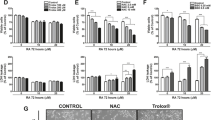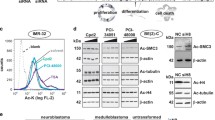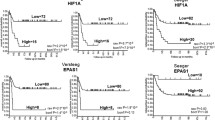Abstract
Glioblastoma is the deadliest and most prevalent brain tumor, which is not yet amenable to any treatments. Therefore, new and innovative therapeutic strategies need to be developed for treating this deadly disease. We found that all-trans retinoic acid (ATRA) or 13-cis retinoic acid (13-CRA) induced astrocytic differentiation with down regulation of telomerase activity in rat glioblastoma C6 cells and enhanced sensitivity of the cells to interferon-gamma (IFN-γ) or taxol (TXL) for apoptosis. Sensitivity of differentiated cells to IFN-γ or TXL was greatly increased for apoptosis with increases in calcineurin expression, Bax:Bcl-2 ratio, mitochondrial release of cytochrome c, and expression and activity of calpain and caspases. Treatment with IFN-γ activated caspase-8 indicating induction of apoptosis via the receptor-mediated pathway. Notably, IFN-γ activated the signal transducer and activator of transcription-1 (STAT-1) for signaling via binding to gamma activator sequence (GAS), whereas TXL activated Raf-1 kinase for inactivation of Bcl-2 by its phosphorylation. We confirmed involvement of different proteolytic mechanisms in cell death by pretreating the cells with caspase-8 inhibitor II, calpeptin (calpain inhibitor), and caspase-9 inhibitor I, and caspase-3 inhibitor IV. Results demonstrated that retinoids induced astrocytic differentiation with down regulation of telomerase activity and worked synergistically to enhance sensitivity of cells to the cytotoxic agent IFN-γ and the cytostatic agent TXL for apoptosis. This combination therapy for differentiation and apoptosis could be highly effective for controlling the malignant growth of glioblastoma.















Similar content being viewed by others
References
Rasheed BK, Wiltshire RN, Bigner SH, Bigner DD (1999) Molecular pathogenesis of malignant gliomas. Curr Opin Oncol 11:162–167
Breitman TR, Collins SJ, Keene BR (1981) Terminal differentiation of human promyelocytic leukemic cells in primary culture in response to retinoic acid. Blood 57:1000–1004
Reynolds CP, Kane DJ, Einhorn PA, Matthay KK, Crouse VL, Wilbur JR, Shurin SB, Seeger RC (1991) Response of neuroblastoma to retinoic acid in vitro and in vivo. Prog Clin Biol Res 366:203–211
Bunn PA Jr, Hoffman SJ, Norris D, Golitz LE, Aeling JL (1994) Systemic therapy of cutaneous T-cell lymphomas (mycosis fungoides and the Sezary syndrome). Ann Intern Med 121:592–602
Aebi S, Kroning R, Cenni B, Sharma A, Fink D, Los G, Weisman R, Howell SB, Christen RD (1997) All-trans retinoic acid enhances cisplatin-induced apoptosis in human ovarian adenocarcinoma and in squamous head and neck cancer cells. Clin Cancer Res 3:2033–2038
Todesco A, Carli M, Iacona I, Frascella E, Ninfo V, Rosolen A (2000) All-trans retinoic acid and interferon-alpha in the treatment of a patient with esistant metastatic osteosarcoma. Cancer 89:2661–2666
Marley SB, Davidson RJ, Goldman JM, Gordon MY (2002) Effects of combinations of therapeutic agents on the proliferation of progenitor cells in chronic myeloid leukaemia. Br J Haematol 116:162–165
Pili R, Kruszewski MP, Hager BW, LantzJ, Carducci MA (2001) Combination of phenylbutyrate and 13-cis retinoic acid inhibits prostate tumor growth and angiogenesis. Cancer Res 61:1477–1485
Thalasila A, Poplin E, Shih J, Dvorzhinski D, Capanna T, Doyle-Lindrud S, Beers S, Goodin S, Rubin E, DiPaola RS (2003) A phase I trial of weekly paclitaxel, 13-cis retinoic acid, and interferon-α in patients with prostate cancer and other advanced malignancies. Cancer Chemother Pharmacol 52:119–124
Vaishampayan U, Flaherty L, Du W, Hussain M (2001) Phase II evaluation of paclitaxel, α-interferon, and cis-retinoic acid in advanced renal cell carcinoma. Cancer 92:519–523
Allenby G, Bocquel M T, Saunders M, Kazmer S, Speck J, Rosenberger M, Lovey A, Kastner P, Grippo JF, Chambon P, et al (1993) Retinoic acid receptors and retinoid X receptors: interactions with endogenous retinoic acids. Proc Natl Acad Sci USA 90:30–34
Veal GJ, Errington J, Redfern CP, Pearson AD, Boddy AV (2002) Influence of isomerisation on the growth inhibitory effects and cellular activity of 13-cis and all-trans retinoic acid in neuroblastoma cells. Biochem Pharmacol 63:207–215
Fujiwara-Akita H, Maesawa C, Honda T, Kobayashi S, Masuda T (2005) Expression of human telomerase reverse transcriptase splice variants is well correlated with low telomerase activity in osteosarcoma cell lines. Int J Oncol 26:1009–1016
Tchirkov A, Rolhion C, Kemeny JL, Irthum B, Puget S, Khalil T, Chinot O, Kwiatkowski F, Perissel B, Vago P, Verrelle P (2003) Clinical implications of quantitative real-time RT-PCR analysis of hTERT gene expression in human gliomas. Br J Cancer 88:516–520
Liu WJ, Zhang YW, Zhang ZX, Ding J (2004) Alternative splicing of human telomerase reverse transcriptase may not be involved in telomerase regulation during all-trans retinoic acid-induced HL-60 cell differentiation. J Pharmacol Sci 96:106–114
Kominsky S, Johnson HM, Bryan G, Tanabe T, Hobeika AC, Subramaniam PS, Torres B (1998) IFN-γ inhibition of cell growth in glioblastomas correlates with increased levels of the cyclin dependent kinase inhibitor p21WAF1/CIP1. Oncogene 17:2973–2979
Tada M, Diserens AC, Desbaillets I, de Tribolet N (1994) Analysis of cytokine receptor messenger RNA expression in human glioblastoma cells and normal astrocytes by reverse-transcription polymerase chain reaction. J Neurosurg 80:1063–1073
Knupfer MM, Poppenborg H, Van Gool S, Domula M, Wolff JE (1997) IFN-γ inhibits proliferation and adhesion of T98G human malignant glioma cells in vitro. Klin Padiatr 209:271–274
Bach EA, Aguet M, Schreiber RD (1997) The IFN-γ receptor: a paradigm for cytokine receptor signaling. Annu Rev Immunol 15: 563–591
Decker T, Kovarik P, Meinke A (1997) GAS elements: a few nucleotides with a major impact on cytokine-induced gene expression. J Interferon Cytokine Res 17:121–134
Kano A, Watanabe Y, Takeda N, Aizawa S, Akaike T (1997) Interferon-gamma inhibits proliferation and adhesion of T98G human malignant glioma cells in vitro. J Biochem (Tokyo) 121:677–683
Ossina NK, Cannas A, Powers VC, Fitzpatrick PA, Knight JD, Gilbert JR, Shekhtman EM, Tomei LD, Umansky SR, Kiefer MC (1997) IFN-γ modulates a p53-independent apoptotic pathway and apoptosis-related gene expression. J Biol Chem 272:16351–16357
Ray SK, Wilford GG, Crosby CV, Hogan EL, Banik NL (1999) Diverse stimuli induce calpain overexpression and apoptosis in C6 glioma cells. Brain Res 829:18–27
Danesi R, Figg WD, Reed E, Myers CE (1995) Paclitaxel (taxol) inhibits protein isoprenylation and induces apoptosis in PC-3 human prostate cancer cells. Mol Pharmacol 47:1106–1111
Jordan MA, Wendell K, Gardiner S, Derry WB, Copp H, Wilson L (1996) Mitotic block induced in HeLa cells by low concentrations of paclitaxel (Taxol) results in abnormal mitotic exit and apoptotic cell death. Cancer Res 56:816–825
Horwitz SB (1994) Taxol (paclitaxel): mechanisms of action. Ann Oncol 6:S3-S6
Haldar S, Jena N, Croce CM (1995) Inactivation of Bcl-2 by phosphorylation. Proc Natl Acad Sci USA 10:4507–4511
Salah-Eldin AE, Inoue S, Tsukamoto S, Aoi H, Tsuda M (2003) An association of Bcl-2 phosphorylation and Bax localization with their functions after hyperthermia and paclitaxel treatment. Int J Cancer 103:53–60
Das A, Banik NL, Patel NJ, Ray SK (2004) Dexamethasone protected human glioblastoma U87MG cells from temozolomide induced apoptosis by maintaining Bax:Bcl-2 ratio and preventing proteolytic activities. Mol Cancer 3:36 (1–10)
Kim NW, Piatyszek MA, Prowse KR, Harley CB, West MD, Ho PL, Coviello GM, Wright WE, Weinrich SL, Shay JW (1994) Specific association of human telomerase activity with immortal cells and cancer. Science 66:2011–2015
Grynkiewicz G, Poenie M, Tsien RY (1995) A new generation of Ca2+ indicators with greatly improved fluorescence properties. J Biol Chem 260:3440–3450
Hansen CA, Monck JR, Williamson JR (1990) Measurement of intracellular free calcium to investigate receptor-mediated calcium signaling. Methods Enzymol 191:691–706
Kang D, Nishida J, Iyama A, Nakabeppu Y, Furuichi M, Fujiwara T, Sekiguchi M, Takeshige K (1995) Intracellular localization of 8-oxo-dGTPase in human cells, with special reference to the role of the enzyme in mitochondria. J Biol Chem 270:14659–14665
Ray SK, Neuberger TJ, Deadwyler G, Wilford G, DeVries GH, Banik NL (2002) Calpain and calpastatin expression in primary oligodendrocyte culture: preferential localization of membrane calpain in cell processes. J Neurosci Res 70:561–569
Nudson WA, Rovnak J, Buechner M, Quackenbush SL (2003) Walleye dermal sarcoma virus Orf C is targeted to the mitochondria. J Gen Virol 84:375–381
Das A, Sribnick EA, Wingrave JM, Del Re AM, Woodward JJ, Appel SH, Banik NL, Ray SK (2005) Calpain activation in apoptosis of ventral spinal cord 4.1 (VSC4.1) motoneurons exposed to glutamate: calpain inhibition provides functional neuroprotection. J Neurosci Res 81:551–562
Pique M, Barragan M, Dalmau M, Bellosillo B, Pons G, Gil J (2000) Aspirin induces apoptosis through mitochondrial cytochrome c release. FEBS Lett 480:193–196
Butt AM (1991) Macroglial cell types, lineage, and morphology in the CNS. Ann N Y Acad Sci 633:90–95
Tascos NA, Parr J, Gonatas NK (1982) Immunocytochemical study of the glial fibrillary acidic protein in human neoplasms of the central nervous system. Hum Pathol 13:454–458
Chiu FC, Goldman JE (1985) Regulation of glial fibrillary acidic protein (GFAP) expression in CNS development and in pathological states. J Neuroimmunol 8:283–292
Yamada O, Takanashi M, Ujihara M, Mizoguchi H (1998) Down-regulation of telomerase activity is an early event of cellular differentiation without apparent telomeric DNA change. Leuk Res 22:711–717
Neradil J, Veselska R, Svoboda A (2005) The role of actin in the apoptotic cell death of P19 embryonal carcinoma cells. Int J Oncol 27:1013–1021
Kass GE, Orrenius S (1999) Calcium signaling and cytotoxicity. Environ Health Perspect 107:25–35
Roy M, Chakrabarty S, Sinha D, Bhattacharya RK, Siddiqi M (2003) Anticlastogenic, antigenotoxic and apoptotic activity of epigallocatechin gallate: a green tea polyphenol. Mutat Res 523–524:33–41
Krammer PH (2000) CD95’s deadly mission in the immune system. Nature 407:789–95
Desagher S, Osen-Sand A, Nichols A, Eskes R, Montessuit S, Lauper S, Maundrell K, Antonsson B, Martinou JC (1999) Bid-induced conformational change of Bax is responsible for mitochondrial cytochrome c release during apoptosis. J Cell Biol 144:891–901
Chen M, He H, Zhan S, Krajewski S, Reed JC, Gottlieb RA (2001) Bid is cleaved by calpain to an active fragment in vitro and during myocardial ischemia/reperfusion. J Biol Chem 276:30724–30728
Piskurich JF, Linhoff MW, Wang Y, Ting JP (1999) Two distinct gamma interferon-inducible promoters of the major histocompatibility complex class II transactivator gene are differentially regulated by STAT1, interferon regulatory factor 1, and transforming growth factor beta. Mol Cell Biol 19:431–440
Kazuhito Y, Hidenori I. Stanley JK (1999) Bcl-2 is phosphorylated and inactivated by an Ask1/Jun N-terminal protein kinase pathway normally activated at G2/M. Mol Cell Biol 19:8469–8478
Wang HG, Pathan N, Ethell IM, Krajewski S, Yamaguchi Y, Shibasaki F, McKeon F, Bobo T, Franke TF, Reed JC (1999) Ca2+-induced apoptosis through calcineurin dephosphorylation of Bad. Science 284:339–343
Nath R, Raser KJ, Stafford D, Hajimohammadreza I, Posner A, Allen H, Talanian RV, Yuen P, Gilbertsen RB, Wang KK (1996) Non-erythroid α-spectrin breakdown by calpain and interleukin-1ß-converting-enzyme-like protease(s) in apoptotic cells: contributory roles of both protease families in neuronal apoptosis. Biochem J 319:683–690
Wang KK, Posmantur R, Nath R, McGinnis K, Whitton M, Talanian RV, Glantz SB, Morrow JS (1998) Simultaneous degradation of αII- and ßII-spectrin by caspase 3 (CPP32) in apoptotic cells. J Biol Chem 273:22490–22497
Wang KK, Posmantur R, Nadimpalli R, Nath R, Mohan P, Nixon RA, Talanian RV, Keegan M, Herzog L, Allen H (1998) Caspase-mediated fragmentation of calpain inhibitor protein calpastatin during apoptosis. Arch Biochem Biophys 356:187–196
Sakahira H, Enari M, Nagata S (1998) Cleavage of CAD inhibitor in CAD activation and DNA degradation during apoptosis. Nature 391:96–99
Hietakangas V, Poukkula M, Heiskanen KM, Karvinen JT, Sistonen L, Eriksson JE (2003) Erythroid differentiation sensitizes K562 leukemia cells to TRAIL-induced apoptosis by downregulation of c-FLIP. Mol Cell Biol 23:1278–1291
Toda M, Miura M, Asou H, Toya S, Uyemura K (1994) Cell growth suppression of astrocytoma C6 cells by glial fibrillary acidic protein cDNA transfection. J Neurochem 63:1975–1978
Linskey ME, Gilbert MR (1995) Glial differentiation: a review with implications for new directions inneuro-oncology. Neurosurgery 36:1–21
Rothwell NJ (1997) Neuroimmune interactions: the role of cytokines. Br J Pharmacol 121:841–847
Sawada M, Itoh Y, Suzumura A, Marunouchi T (1993) Expression of cytokine receptors in cultured neuronal and glial cells. Neurosci Lett 160:131–134
Deshpande RV, Goust JM, Chakrabarti AK, Barbosa E, Hogan EL, Banik NL (1995) Calpain expression in lymphoid cells. Increased mRNA and protein levels after cell activation. J Biol Chem 270:2497–2505
Wang Q, Yang W, Uytingco MS, Christakos S, Wieder R (2000) 1,25-Dihydroxy vitamin D3 and all-trans retinoic acid sensitize breast cancer cells to chemotherapy-induced cell death. Cancer Res 60:2040–2048
Figueroa-Masot XA, Hetman M, Higgins MJ, Kokot N, Xia Z (2001) Taxol induces apoptosis in cortical neurons by a mechanism independent of Bcl-2 phosphorylation. J Neurosci 21:4657–4667
Blagosklonny MV, Giannakakou P, Deiry WS, Kingston DG, Higgs PI, Neckers L, Fojo T (1997) Raf-1/Bcl-2 phosphorylation: a step from microtubule damage to cell death. Cancer Res 57:130–135
Ray SK, Matzelle DD, Wilford GG, Hogan EL, Banik NL (2001) Cell death in spinal cord injury (SCI) requires de novo protein synthesis: Calpain inhibitor E-64-d provides neuroprotection in SCI lesion and penumbra. Ann N Y Acad Sci 939:436–449
Waters SL, Sarang SS, Wang KK, Schnellmann RG (1997) Calpains mediate calcium and chloride influx during the late phase of cell injury. J Pharmacol Exp Ther 283:1177–1184
Gil-Parrado S, Fernandez-Montalvan A, Assfalg-Machleidt I, Popp O, Bestvater F, Holloschi A, Knoch TA, Auerswald EA, Welsh K, Reed JC, Fritz H, Fuentes-Prior P, Spiess E, Salvesen GS, Machleidt W (2002) Ionomycin-activated calpain triggers apoptosis: A probable role for Bcl-2 family members. J Biol Chem 277:27217–27226
Scarlett JL, Sheard PW, Hughes G, Ledgerwood EC, Ku HH, Murphy MP (2000) Changes in mitochondrial membrane potential during staurosporine-induced apoptosis in Jurkat cells. FEBS Lett 475:267–272
Adams JM, Cory S (2001) Life-or-death decisions by the Bcl-2 protein family. Trends Biochem Sci 26:61–66
Acknowledgments
This study was supported in part by the R01 grants from the NCI (CA-91460) and NINDS (NS-57811) and a Spinal Cord Injury Research Foundation grant from the State of SC (SCIRF-0803) to S.K.R.
Author information
Authors and Affiliations
Corresponding author
Additional information
Special issue in honor of Naren Banik.
Rights and permissions
About this article
Cite this article
Das, A., Banik, N.L. & Ray, S.K. Differentiation Decreased Telomerase Activity in Rat Glioblastoma C6 Cells and Increased Sensitivity to IFN-γ and Taxol for Apoptosis. Neurochem Res 32, 2167–2183 (2007). https://doi.org/10.1007/s11064-007-9413-y
Received:
Accepted:
Published:
Issue Date:
DOI: https://doi.org/10.1007/s11064-007-9413-y




